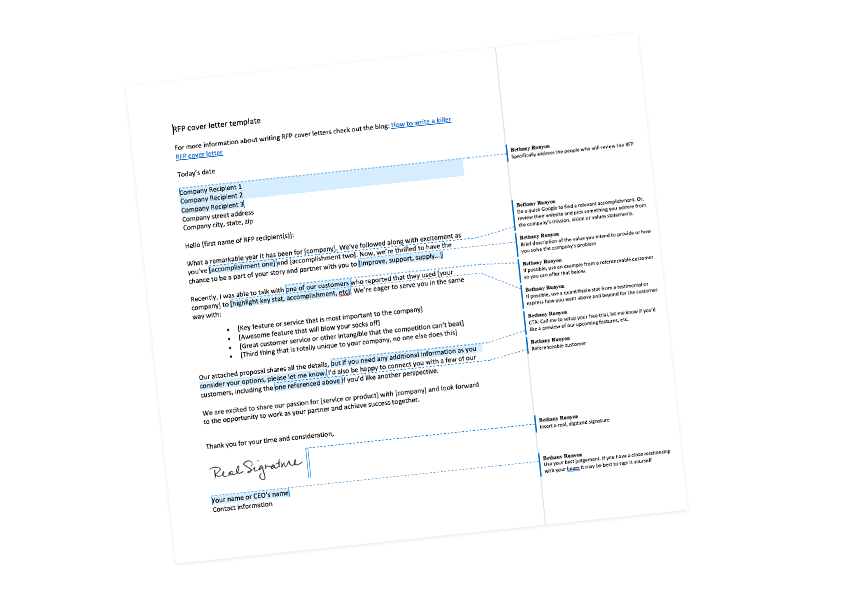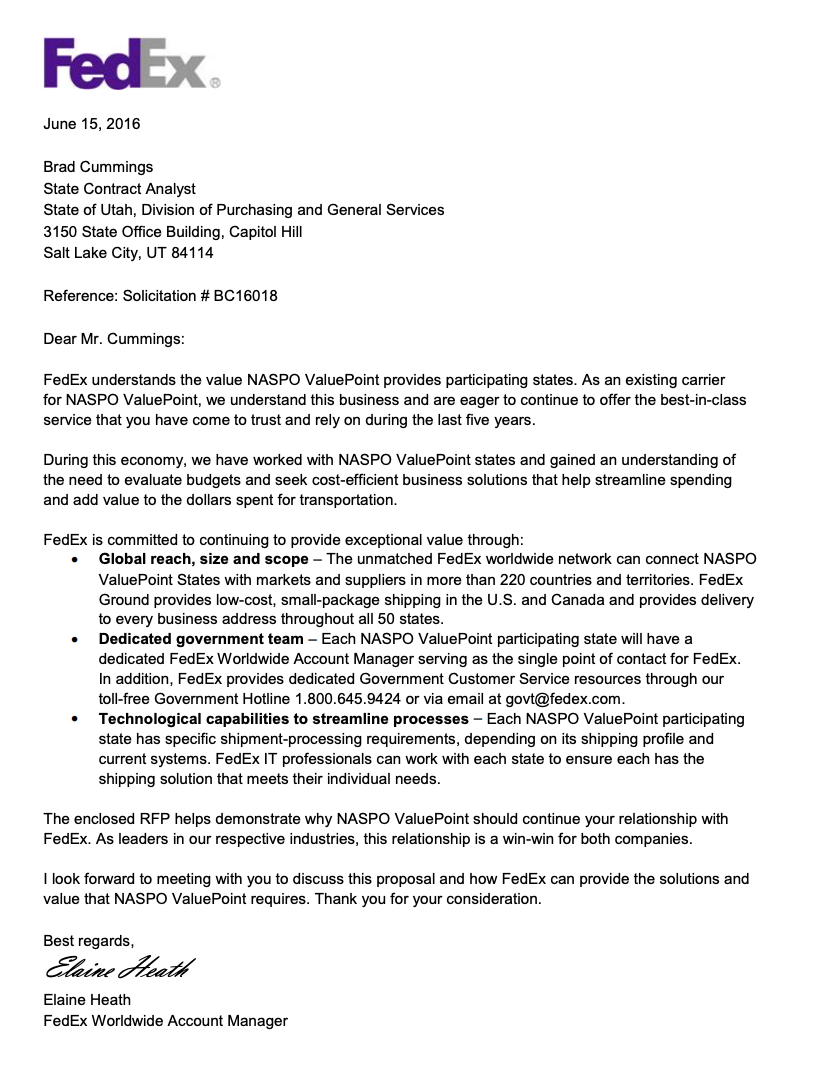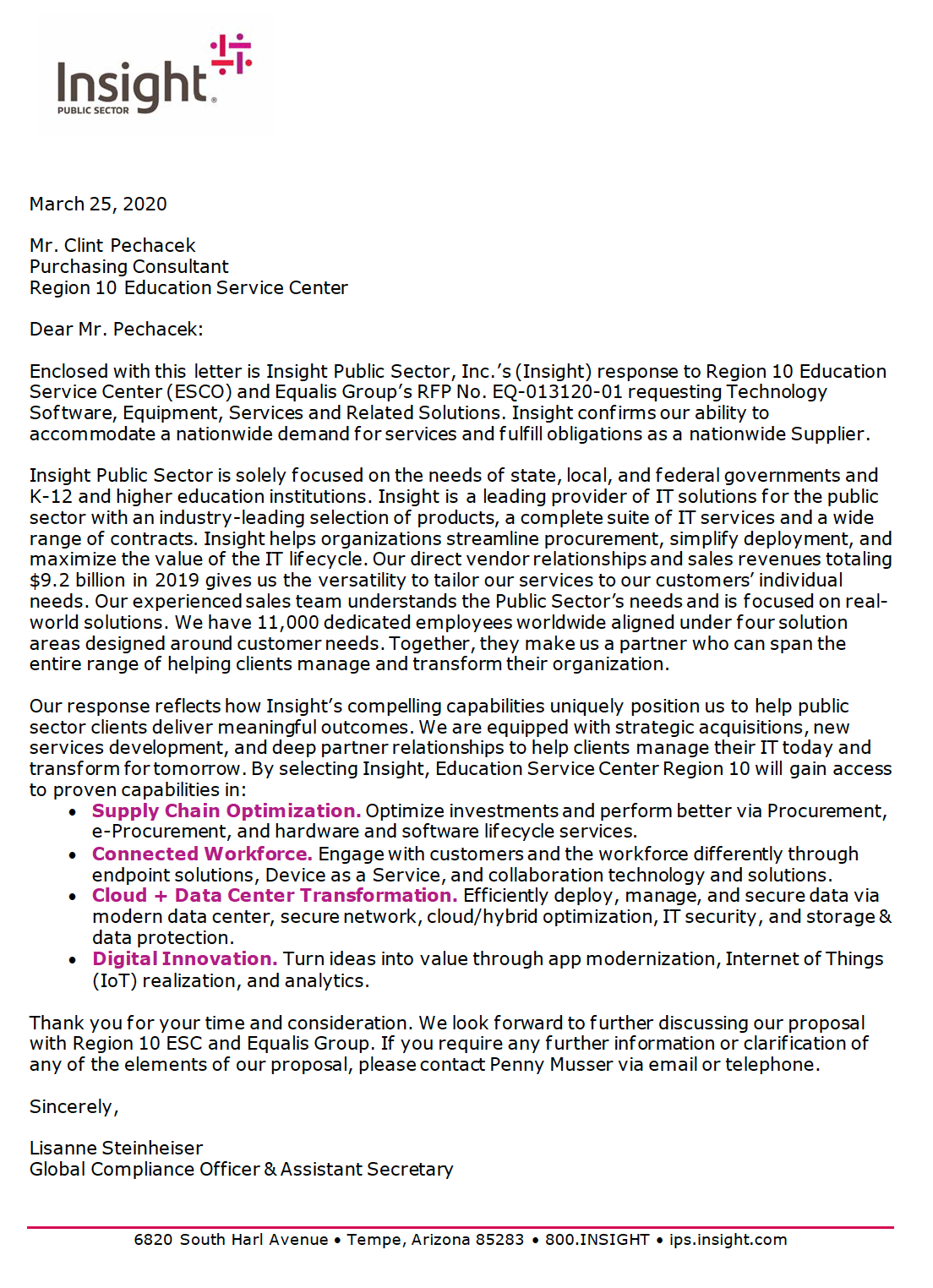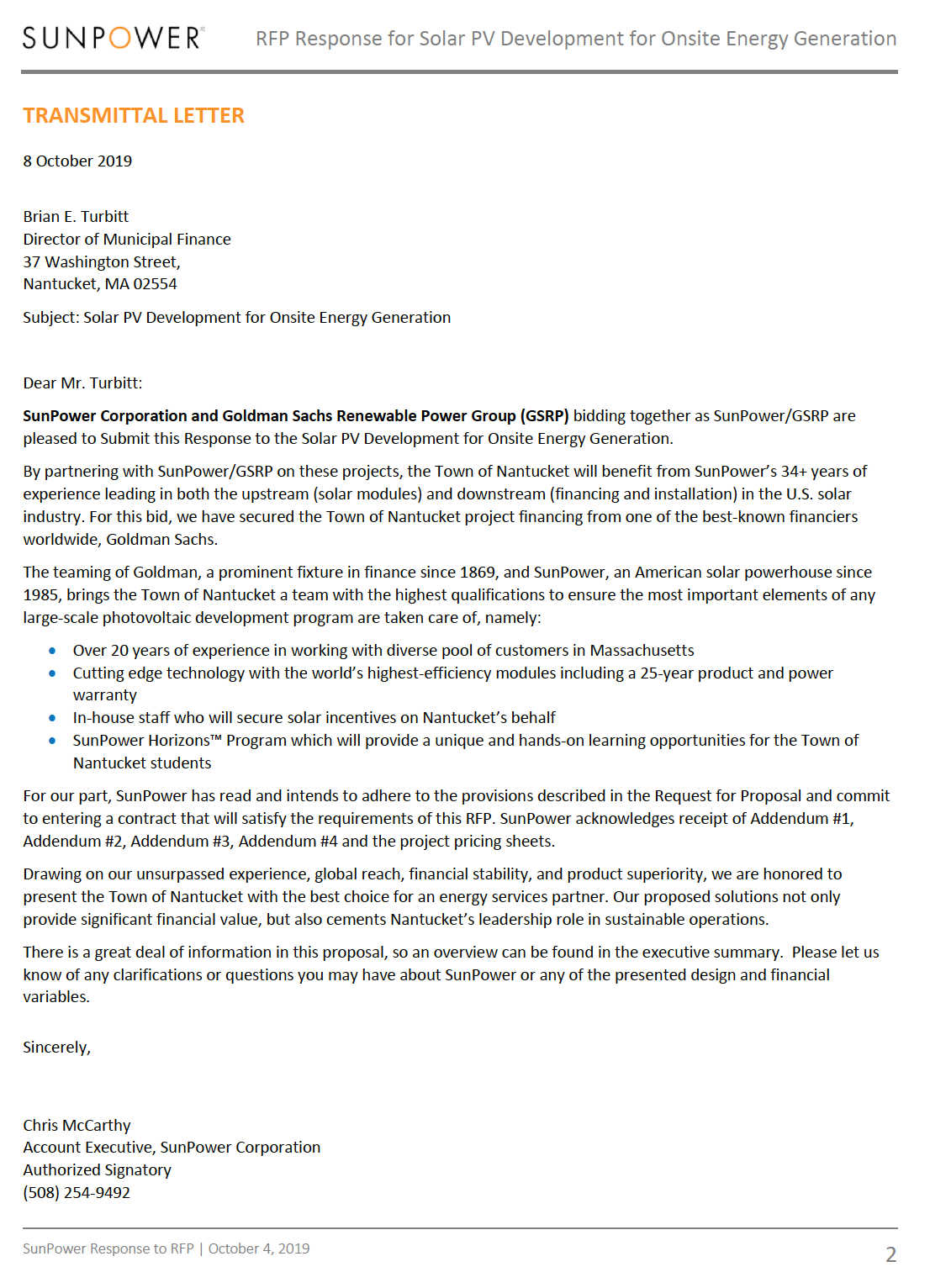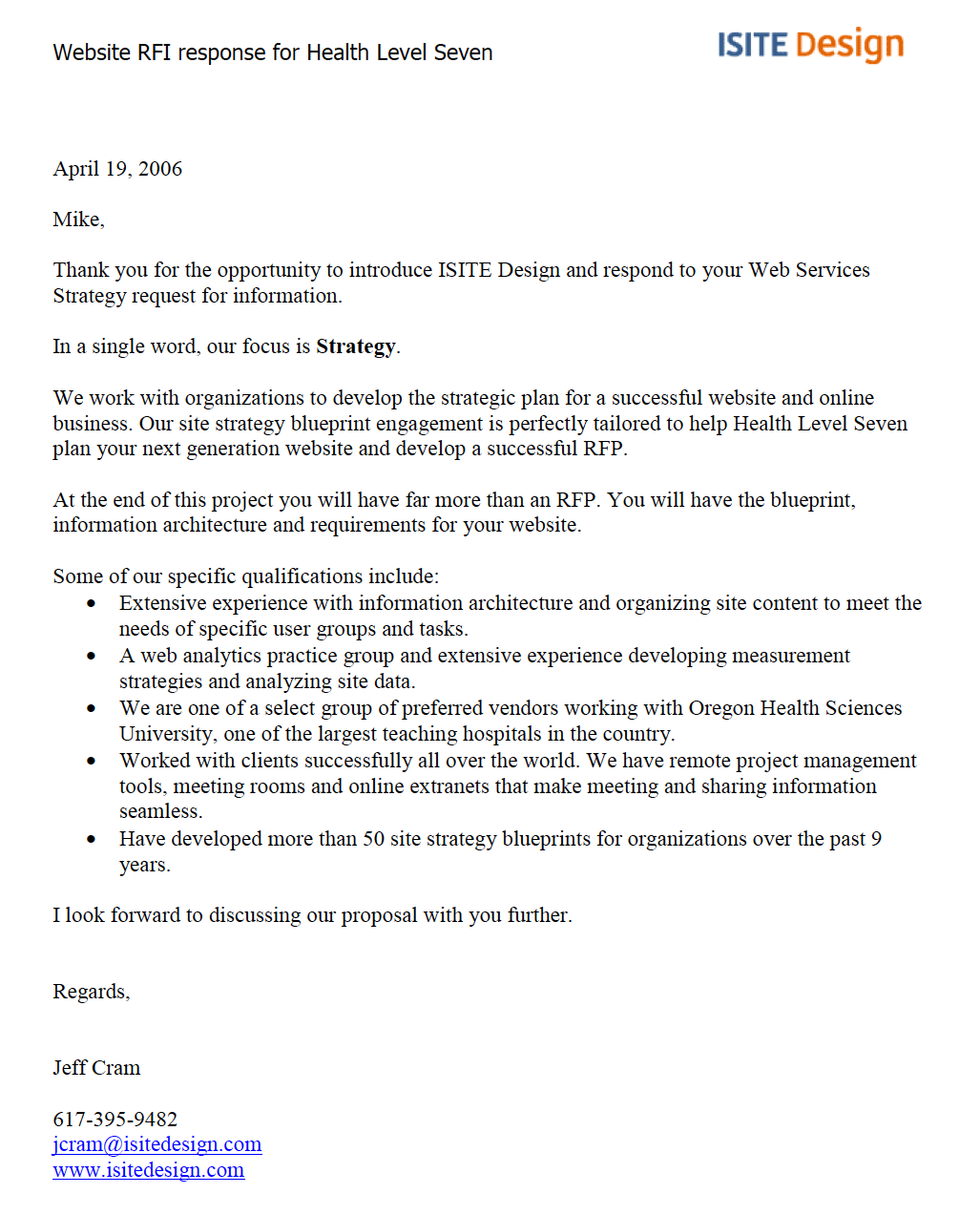RFP360 is a part of RFPIO, the leading response management software. To explore more tips for creating compelling content and writing a winning RFP cover letter, visit RFPIO.com.
After weeks of work, you’ve finally put the finishing touches on your request for proposal (RFP) response. The proposal is a product of the hours you invested customizing past content, collaborating with subject matter experts and refining your messaging. Because of your efforts, the proposal is a masterpiece — creative, comprehensive and compelling. Consequently, you’re feeling confident. After all, your company should win this business — you’ve earned it. Now, there’s only one thing left to do… slap a proposal cover letter on top, submit it and move on to the next RFP.
But wait. Not so fast. When was the last time you read your boilerplate RFP cover letter? Like, actually read it. If you’re like many others, it’s been a while. Unfortunately, that means you might not be putting your best foot forward.
So, before you send off that RFP response, let’s take a closer look at your proposal cover letter and be sure it accurately represents your proposal. With a couple easy tips and a quick review, your cover letter will send just the right message.
In this post, we’ll explore what a proposal cover letter is and why it matters. Then, I’ll explain what a cover letter includes, tips for writing a winning letter and a few sample RFP cover letters. Finally, I’ll share a proposal cover letter template you can download and customize to get a head start.
- What is a proposal cover letter?
- Why a well-written cover letter matters
- Basics to know before you start your cover letter
- Parts of a proposal
- Components of a cover letter
- What your RFP cover letter should do
- Beyond the basics: Six tips to writing a better RFP cover letter
- Getting started: RFP cover letter example and template
- Helpful response resources
Download the RFP cover letter template now.
What is a proposal cover letter?
A proposal cover letter is a single-page letter addressed to a prospective customer containing high-level information from a prospective vendor. The letter precedes an accompanying RFP response or business proposal.
Alternative names for the proposal cover letter include RFP response cover letter, bid proposal cover letter, RFP cover page and other similar variations. No matter what it’s called, the cover letter is your chance to introduce your business and offer to a potential new customer. As such, you need to make it count.
Why a well-written cover letter matters
You spend hours working through the proposal process, so why should you spend even more time crafting an RFP response cover letter? The proposal cover letter is an oft-overlooked sales tool. Indeed, it’s a zero-cost way to get your message directly to the people who decide whether or not your proposal wins. Furthermore, the RFP cover letter takes very little time to compose (especially if you use our template below) and offers you one more way to stand out from your competitors.
If you’re like most businesses, your cover letter can probably be summarized like this: “Dear Mr. or Ms. Company — Thank you so much for this opportunity. Included in this proposal you will find our answers that meet the requested specifications. Thank you for your consideration.”
While common, this isn’t a terribly compelling way to introduce yourself to a new customer that could help you grow your business. Your RFP cover letter provides a first impression to the proposal evaluators and decision makers reviewing your proposal.
Think of it this way: If you were going to present your proposal in person, how would you greet the buyer? You’d probably wear your best suit, walk confidently, put on a warm smile and share a confident handshake to make a memorable introduction. It should be the same with your proposal cover letter. Unfortunately, if your letter is anything like the example above, it’s like showing up in sweatpants and offering an unenthusiastic, mumbled greeting.
The RFP cover letter can also be used to:
- Create or deepen the connection between you and your buyer
- Reinforce your brand, values and expertise
- Promote your key differentiators
- Establish primary point(s) of contact
No matter how you use the RFP cover letter and what you put in it, remember that the person receiving it is just that — a person. The quality of your bid proposal cover letter determines whether they read it carefully, skim it quickly or ignore it completely. Generally, proposal cover letters are memorable either because they are embarrassingly bad or extraordinarily good. Make your cover letter memorable for the right reasons.
Basics to know before you start your proposal cover letter
The RFP cover letter should be included as a normal part of every proposal, but it’s just one component. Indeed, most proposals also include a number of other elements that will generally appear in a specific order.
Parts of a proposal
- Cover letter
- Executive summary
- Proposal
- Addendums
- Terms and conditions
- Supporting documentation (Case studies, references and additional data)
Components of a cover letter
As the first element of your proposal, the cover letter is bound to be seen by a lot of people. So, it’s important to make sure it is the best possible representation of your company. But, how do you decide what to say? One of the biggest challenges when writing an RFP response letter is how to keep it short while also making an impact — remember, your cover letter should fit on a single page. To help you craft your message, focus on these five elements.
- Addressees
- Greeting and introduction
- Summary of RFP needs
- Your broad qualifications and differentiators
- Thank you and closing
Your RFP cover letter should:
- Be the first page of your RFP response followed by your executive summary and proposal
- Introduce your company to the buyer’s key decision makers and any others reviewing or scoring your bid
- Be conversational, genuine and confident — but it shouldn’t be an overt sales pitch
- Offer an overview of your understanding of the company’s needs
- Clearly state why your business is uniquely qualified to win the RFP opportunity
- If possible, express your vision for the future partnership and how you can help the business reach its goals
- Follow the customer’s instructions if they ask you to include specific information in the cover letter
What’s the difference between a cover letter and an executive summary?
When building formal RFP responses, this question comes up a lot. What is the difference between a cover letter and an executive summary? The confusion is understandable as the two documents share a lot of similarities. They are both short, introductory documents that precede your proposal.
The primary distinction is that a proposal cover letter is an introduction to your company while the executive summary is an overview of your offer for a specific project. In addition, the cover letter should almost always fit on a single page while the executive summary may be two or three pages if necessary. Admittedly, the difference is subtle. While the contents may seem to naturally overlap, try to avoid repetition and ensure that each document provides unique information.
Download our executive summary template to see an example.
Beyond the basics: Six tips to writing a better RFP cover letter
1. Address it to the right people
Who is going to review your proposal? If you don’t already know, find out. Get in touch with the RFP contact and ask for the names of the key contacts who will weigh in on the decision. This may be a committee of people or a combination of procurement professionals, stakeholders and executives.
If you start your RFP response letter with the standard “To whom it may concern” salutation, you’re blending in and sending a message. Unfortunately, this approach communicates that you couldn’t be bothered to update your cover letter template, didn’t do your homework and don’t really care that much about winning the business. It certainly doesn’t reflect the hours of time you’ve likely invested creating the proposal that follows.
By specifically addressing the proposal cover letter to the key contacts, you make a quick connection and instantly improve the chances that they’ll actually read the bid proposal cover letter and your subsequent proposal. This attention to detail reinforces the idea that not only are you a good fit based on your qualifications, but you’re also invested in developing deeper relationships. You’re in it to be a strategic partner, not just another vendor.
2. Keep it fresh and be human
Put yourself in your recipient’s shoes — You’ve just received dozens of proposals from vendors who more or less provide the same type of services. You are starting to sift through RFP responses that are admittedly, probably pretty dry. The initial review checking for proposal compliance is time consuming, highly repetitive and gets old quick.
So, if a cover letter starts with something like, “Thank you for the opportunity to earn your business,” it’s just adding to the tedium. It’s a classic and well-worn opening line. While it’s good to be humble and grateful, it’s far better to be unique and memorable. A recent post featured in APMP’s Winning the Business,
“… never start a cover letter with “thank you.” It’s boring, and almost everyone does it. This seemingly respectful thank you does not help your organization to stand out or inspire your reader to keep reading.”
The article goes on to recommend starting with something specific and complimentary about the business. This opener accomplishes two things; it quickly shows that this is no ordinary copy-and-paste proposal cover letter while reinforcing that you did your homework and recognize the business’s goals.
In an increasingly automated and efficient world, it’s easy to forget about the people behind the process. Even if you use RFP software to quickly complete the RFP itself, the RFP cover letter offers a rare opportunity to be human and genuine.
3. Use formatting to catch their eye
Your cover letter only helps you win the business if it actually gets read by the right people. Just like using the perfect proposal format, the right cover letter format invites the reader to engage. So, make sure your cover letter is clean, visually appealing, approachable and not too dense. Remember that you’re trying to make an impression, not dive into every detail of your proposal.
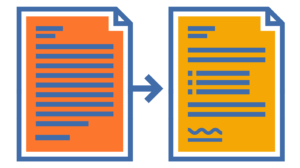
Because your cover letter only uses one page, you have to be smart about how you use the space. There are three main places where you have the best chance to hook the reader: the first sentence, the center of the page and the closing.
Opening
Nothing catches your eye like your own name. So, as suggested above, address the letter directly to the evaluator(s). Then, include the buyer’s company name in a unique and impactful opening sentence.
Center
Make the most of the center of your RFP response letter using bullet points. Draw the eye directly to your biggest differentiators without specifically calling out your competitors. Include what you excel at like customer support, on-time delivery, cutting-edge features, value adds, scalability, customer growth and so on.
Closing
Use the final line to move the deal forward. Offer the prospect a clear and direct call to action (see tip six for more information and an example). For example, provide details about how they can move forward with you, request the information you need to speed up contracting or share what comes next in the process.
If you can engage a reader in any one of these areas, they are far more likely to take the time to read your entire cover letter. Ideally, it’s intriguing enough that they continue on to check out your executive summary and proposal as well.
4. Tell a tale and express your understanding
Have a success story with a similar client that could boost your credibility? Tell it, but be brief. Share how a partnership has been mutually rewarding, how you’ve delivered a great customer experience or how you’ve been able to proactively solve problems. This reinforces your understanding of their business and goals.
In addition to telling a story, you can use your proposal cover letter to express your understanding of their pain. Every RFP starts with a need, and you received the RFP because the company believes you can meet that need. So, consider building on that foundation.
The relationship between buyers and sellers is evolving. More and more, businesses are looking for a long-term partner, someone who will actively find opportunities to create wins for both parties. RFP issuers want value but they also want a vendor that is invested in their success.
5. Stay true to your brand
Your company was included in the bid process for a reason, so stay true to the persona, culture, values and tone of your brand. Just because the RFP process is formal, doesn’t mean your RFP cover letter has to be. If your company prides itself on being down-to-earth, use that style in all of your communications.
Recently I was talking to our resident RFP issuing expert and RFP360 Co-Founder, Dave Hulsen, about the importance of RFP cover letters. During his days in procurement, he received hundreds of cover letters so I asked if there were any memorable trends that raised red flags. On several occasions he found himself reading cover letters that left him confused. He recounted his reaction to these saying,
“I would issue RFPs to vendors based on engaging conversations where I felt like the vendor understood what I needed. Then I’d read the robotic, boring proposal cover letters and do a mental double-take. What happened to the welcoming, empathetic salesperson who understood my business?”
Make sure that the tone of your cover letter accurately represents your brand and builds on the relationship you’ve cultivated. Don’t confuse your prospect by approaching them as if they were a stranger or in an unrecognizable style.
6. Close with a call to action, contact information and an actual signature
While the cover letter should be friendly, relatable and genuine; it’s also still a part of the sale. As with any good sales communication, state what you want them to do next and who they can contact to follow up.
Wrap up your RFP cover letter with a call to action like:
- Please reach out with any questions you may have
- We’re eager to show you more — when we can schedule a demo with your team?
- Let me know if I can put you in touch with another customer for a reference
- To accelerate the contracting process, please send your standard terms and conditions
And the final element in a winning RFP cover letter is an actual signature (either handwritten or digital). It may not seem like a big deal, but it’s a nice touch and one last way to show your investment in winning the RFP opportunity.
Get started with this RFP cover letter example and template
Sample RFP cover letter
Even for seasoned proposal professionals, it’s a challenge to start a brand new bid proposal cover letter from scratch, so below you’ll find an example. Hopefully, it will give you a head start on your next great RFP response. This Microsoft Word cover letter template is easily customizable to meet your needs.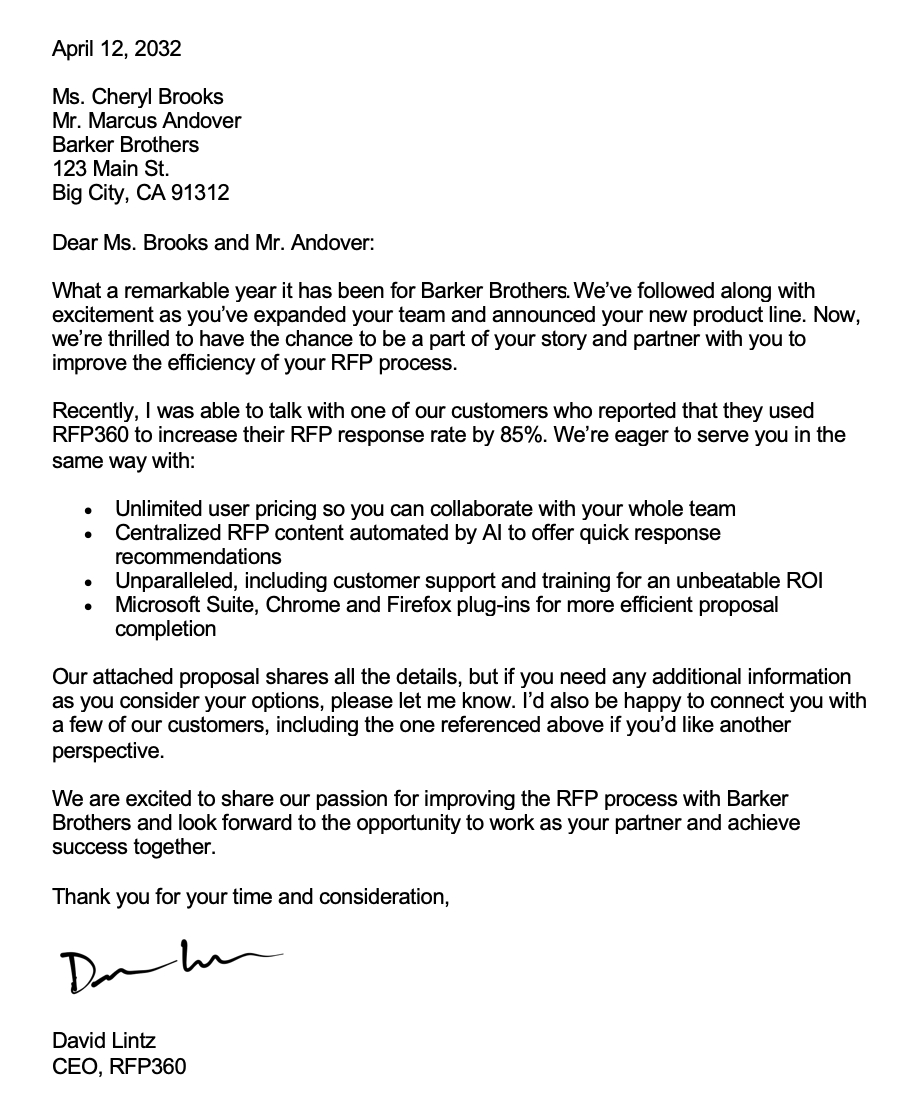
RFP cover letter template
Ready to start crafting your own RFP cover letter? Check out this template that provides guidance on how to use the example above to create your own killer RFP cover letter.
Download the RFP cover letter template now.
Additional RFP cover letter examples
RFP cover letter sample – FedEx to State of Utah
If you only look at one other RFP cover letter sample, make it this one. This sample cover letter and accompanying proposal from FedEx is one of our favorites. Indeed, this request for proposal cover letter follows all the best practices. It includes:
- A specific addressee
- An engaging opening line
- Excellent formatting and bullet points
- A statement of experience
- Simple, but recognizable branding
- A real signature
Sample proposal cover letter – Insight Public Sector to Education Service Center (ESCO)
This proposal cover letter example introduces Insight Public Sector’s response to ESCO’s RFP for technology software, equipment, services and solutions. The letter fits on a single page, reaffirms the company’s qualifications and uses colorful bullet points to draw the eye to the company’s primary differentiators.
Proposal transmittal letter example – SunPower/GSRP for Town of Nantucket
The RFP response letter focuses on the experience and financial stability of the two vendors partnering to win the business. In addition, the letter confirms the companies’ ability to meet the specific qualifications set forth in the RFP for solar PV development for onsite energy generation.
RFP response cover letter sample – ISITE Design for Health Level Seven
While this cover letter uses the standard opening line, it’s scannable, brief and makes use of bullet points to highlight the company’s qualifications. In addition, the letter is addressed directly to the proposal evaluator. It’s a warm introduction for the Web services strategy proposal that follows.
Helpful RFP response resources
Looking for more tools and information to help you write the perfect RFP response? Check the helpful resources below.
Guide to writing an executive summary
Do you know the difference between the executive summary and your RFP cover letter? Learn more in this blog that explores how to write an executive summary that stands out. It also offers an example and template you can download.
How to write an executive summary that stands out
Top RFP response tools
A good RFP tool can make all the difference. Luckily, there are a ton of great tools and resources available for proposal professionals. From RFP management to proposal design, this blog offers recommendations for anything you might need help with.
21 best RFP response tools for 2021
RFP proposal templates and tools
Looking for some inspiration to freshen up your proposal template? We’ve collected some great examples of proposals as well as tools to create them. Explore all the possibilities and give your next proposal new life.
Proposal templates, formats and tools: Create better RFP responses faster
Originally published October 17, 2019 — Updated June 18, 2021

